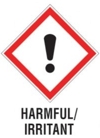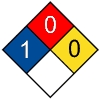| Safety Data Sheet | 235-4010 |
|
CircuitMedic, 22 Parkridge Road, Haverhill, MA 01835 USA Phone: 978-373-1600 | Website: www.circuitmedic.com CircuitMedic disclaims all liability associated with the use of this information. |
Revision Date: May 23, 2024
|
| Section 1. CHEMICAL PRODUCT AND COMPANY IDENTIFICATION | |
| Product Name: | Heat Shield Blanket |
| Product Number: | 235-4010 |
| UFI Number: | M8E9-7SD9-G60K-2R5G |
| Recommended use: | Self-adhering aluminized heat shield material used for reflecting radiant energy. Normally supplied in 5" x 7" sheets. |
| Supplier: | CircuitMedic 22 Parkridge Road, Haverhill, MA 01835 USA PHONE: 978-373-1600, FAX: 978-372-5700 |
| Emergency Response: | For Chemical Emergency Spill, Leak, Fire, Exposure, or Accident Call CHEMTREC Day or Night Within USA and Canada: 1-800-424-9300 CCN4877 Outside USA and Canada: +1 703-527-3887 (collect calls accepted) |
Safety Data Sheet No. 235-4010
CircuitMedic, 22 Parkridge Road, Haverhill, MA 01835 USA
CircuitMedic, 22 Parkridge Road, Haverhill, MA 01835 USA
Page 1 of 8
Revision Date: May 23, 2024
Revision Date: May 23, 2024
| Section 2. HAZARD IDENTIFICATION | ||
| 2.1 Classification of the substance or mixture | ||
| Classification in Accordance with 29 CFR 1910 (OSHA HCS): Health, Specific target organ toxicity - Single exposure, 3 Health, Skin corrosion/irritation, 3 |
||
| 2.2 Label Elements | ||
| Hazard pictograms: |
|
|
| Signal Words: | Warning | |
| GHS Class: | No information available. | |
| Hazard Statements: | H335 - May cause respiratory irritation. H316 - Causes mild skin irritation. |
|
| Precautionary Statements: | P264 - Wash thoroughly after handling. | |
| 2.3 Other Hazards | ||
| Route of Entry: This material may enter the body through inhalation of nuisance dust. Target Organs: Respiratory system. Inhalation: Sore, raspy throat. Skin Contact: Redness and possible rash. Eye Contact: Itching and redness. Ingestion: N/A |
||
| Section 3. COMPOSITION, INFORMATION OR INGREDIENTS | ||
| 3.1. Substance | ||
| Not applicable | ||
| 3.2 Mixtures | ||
| C.A.S. Number | Concentration | Chemical Name |
| 65997-17-3 | 68-78% | Fibrous Glass |
| 7429-90-5 | 7.3-9.3% | Aluminum Foil |
| 67700-43-0 | 1.8-2.8% | Urethane Adhesive |
| 9003-01-4 | 15.4-17.4% | Acrylic Adhesive |
| 63394-01-4 | - | Silicone Coated Paper |
Exposure Limits: OSHA PEL 15 mg/m3 (total), 5 mg/m3 (respirable). ACGIH TLV 1 f/cc
Safety Data Sheet No. 235-4010
CircuitMedic, 22 Parkridge Road, Haverhill, MA 01835 USA
CircuitMedic, 22 Parkridge Road, Haverhill, MA 01835 USA
Page 2 of 8
Revision Date: May 23, 2024
Revision Date: May 23, 2024
| Section 4. FIRST AID MEASURES | |
| 4.1 Description of first aid measures | |
| Inhalation: | Remove person to fresh air. If condition persists, seek medical attention. |
| Skin Contact: | Rinse with copious quantities of cool water. If rash or itching persists, seek medical attention. |
| Eye Contact: | Rinse with water. Do not rub eyes. Seek medical attention. |
| Ingestion: | Not applicable. |
| 4.2. Most important symptoms and effects, both acute and delayed | |
| No additional information. | |
| 4.3 Indication of any immediate medical attention and special treatment needed | |
| No additional information. | |
| Section 5. FIRE-FIGHTING MEASURES | |
| 5.1 Extinguishing media | |
| Extinguishing Media: | Water, carbon dioxide, or dry chemical. |
| Unsuitable Media: | No additional information. |
| 5.2 Special hazards arising from the substance or mixture | |
| Hazardous Combustion Byproducts: | Thermal decomposition of fiber coating may produce irritating smoke or fumes. |
| Unusual Fire Hazards: | No additional information. |
| 5.3 Advice for firefighters | |
| Fire Fighting Instructions: | Thermal decomposition of fiber coating may produce irritating smoke or fumes. |
| Protective Equipment: | Wear self-contained breathing apparatus and full protective gear. |
| Section 6. ACCIDENTAL RELEASE MEASURES | |
| 6.1 Personal precautions, protective equipment and emergency procedures | |
| Personnel Precautions: | No additional information. |
| 6.2 Environmental precautions | |
| Environmental Precautions: | No additional information. |
| 6.3 Methods and material for containment and cleaning up | |
| Methods for Containment: | Material is a solid in roll form. If accidentally released, rewind material back onto roll. |
| Methods for Cleanup: | Material is a solid in roll form. If accidentally released, rewind material back onto roll. |
| Other Spill Precautions: | No information available. |
| 6.4 Reference to other sections | |
| No additional information. | |
Safety Data Sheet No. 235-4010
CircuitMedic, 22 Parkridge Road, Haverhill, MA 01835 USA
CircuitMedic, 22 Parkridge Road, Haverhill, MA 01835 USA
Page 3 of 8
Revision Date: May 23, 2024
Revision Date: May 23, 2024
| Section 7. HANDLING AND STORAGE | |
| 7.1 Precautions for safe handling | |
| Handling: | Use adequate material handling equipment. |
| Special Handling: | No information available. |
| Hygiene Practices: | Use good personal hygiene practices. |
| 7.2 Conditions for safe storage, including any incompatibilities | |
| Storage: | Store in dry place. Use may be at temperature extremes based on product data, but storage should be at ambient temperature. |
| 7.3. Specific end use(s) | |
| No additional information. | |
| Section 8. EXPOSURE CONTROLS AND PERSONAL PROTECTION | |
| 8.1 Control parameters | |
| Local exhaust; dust collection. | |
| 8.2 Exposure controls | |
| Engineering Controls: | Local exhaust; dust collection. |
| Individual protection measures | |
| Eye Protection: | Safety glasses. |
| Skin Protection: | Cotton gloves; long sleeve clothing. |
| Respiratory Protection: | No information available. |
| Other Protective: | No information available. |
| Hygiene Practices: | Wash thoroughly with soap and water after handling. |
No information available.
Safety Data Sheet No. 235-4010
CircuitMedic, 22 Parkridge Road, Haverhill, MA 01835 USA
CircuitMedic, 22 Parkridge Road, Haverhill, MA 01835 USA
Page 4 of 8
Revision Date: May 23, 2024
Revision Date: May 23, 2024
| Section 9. PHYSICAL AND CHEMICAL PROPERTIES | |
| Appearance: | Aluminized Fabric Tape |
| Physical state: | Solid |
| Odor: | No Odor |
| Specific Gravity or Density: | 2.2 |
| Solubility: | Negligible |
| Boiling point: | Not applicable |
| Freezing or Melting Point: | > 500 F |
| Vapor Pressure: | Not applicable |
| Vapor Density: | Not applicable |
| Potentia Hydrogenii: | Not applicable |
| Section 10. STABILITY AND REACTIVITY | |
| 10.1 Reactivity | |
| Reactivity: | No applicable information available. |
| 10.2 Chemical Stability | |
| Chemical Stability: | Material is stable. |
| 10.3 Possibility of hazardous reactions | |
| Hazardous Polymerization: | Will not occur. |
| 10.4 Conditions To Avoid | |
| Conditions To Avoid: | None known. |
| 10.5 Incompatible Materials | |
| Incompatible Materials: | Strong oxidizing agents. |
| 10.6 Hazardous decomposition products | |
| Carbon monoxide; carbon dioxide; nitrogen oxide; cyanide. | |
Safety Data Sheet No. 235-4010
CircuitMedic, 22 Parkridge Road, Haverhill, MA 01835 USA
CircuitMedic, 22 Parkridge Road, Haverhill, MA 01835 USA
Page 5 of 8
Revision Date: May 23, 2024
Revision Date: May 23, 2024
| Section 11. TOXICOLOGICAL INFORMATION | |
| 11.1 Information on toxicological effects | |
| Inhalation: | Direct contact with fiberglass materials or exposure to airborne fiberglass dust may irritate the skin, eyes, nose and throat. Breathing fibers may irritate the airways resulting in coughing and a scratchy throat. Some people are sensitive to the fibers, while others are not. |
| Ingestion: | No know information. |
| Skin Contact: | Direct contact with fiberglass materials or exposure to airborne fiberglass dust may irritate the skin, eyes, nose and throat. Fiberglass can cause itching due to mechanical irritation from the fibers. This is not an allergic reaction to the material. |
| Eye Contact: | Direct contact with fiberglass materials or exposure to airborne fiberglass dust may irritate the skin, eyes, nose and throat. |
| Section 12. ECOLOGICAL INFORMATION | |
| 12.1 Toxicity | |
| Ecotoxicity: | No known hazards except for airborne fibers caused by nuisance dust. 10 milligrams per cubic meter for fiber diameters less than 7 microns. |
| Aquatic Toxicity: | No information available. |
| 12.2 Persistence and degradability | |
| Environmental Fate: | No information available. |
| 12.3 Bioaccumulative potential | |
| No information available. | |
| 12.4 Mobility in soil | |
| No information available. | |
| Section 13. DISPOSAL CONSIDERATIONS | |
| 13.1 Waste treatment methods | |
| Waste Disposal: | Incineration preferred in a federal, state, or local approved facility. |
| Section 14. TRANSPORT INFORMATION | |
| Special transportation: | No special transportation required. |
Safety Data Sheet No. 235-4010
CircuitMedic, 22 Parkridge Road, Haverhill, MA 01835 USA
CircuitMedic, 22 Parkridge Road, Haverhill, MA 01835 USA
Page 6 of 8
Revision Date: May 23, 2024
Revision Date: May 23, 2024
| Section 15. REGULATORY INFORMATION | |||
| C.A.S. Number | Concentration | Chemical Name | Codes |
| 65997-17-3 | 68-78% | Fibrous Glass | TSCA |
| 7429-90-5 | 7.3-9.3% | Aluminum Foil | EPCRAWPC, MASS, NJHS, OSHAWAC, PA, SARA313, TSCA, TXAIR |
| 67700-43-0 | 1.8-2.8% | Urethane Adhesive | TSCA |
| 9003-01-4 | 15.4-17.4% | Acrylic Adhesive | TSCA |
| 63394-01-4 | - | Silicone Coated Paper | - |
Codes
TSCA: Toxic Substances Control Act
EPCRAWPC: EPCRA Water Priority Chemicals
MASS: MA Massachusetts Hazardous Substances List
NJHS: NJ Right-to-Know Hazardous Substances
OSHAWAC: OSHA Workplace Air Contaminants
PA: PA Right-To-Know List of Hazardous Substances
SARA313: SARA 313 Title III Toxic Chemicals
TXAIR: TX Air Contaminants with Health Effects Screening Level
15.1 Safety, health and environmental regulations/legislation specific for the substance or mixture
EU legislation:
Regulation (EC) No 1272/2008 of the European Parliament and of the Council of 16 December 2008 on classification, labelling and packaging of substances and mixtures (as amended).
COMMISSION REGULATION (EU) 2015/830 of 28 May 2015 amending Regulation (EC) No 1907/2006 of the European Parliament and of the Council on the Registration, Evaluation, Authorisation and Restriction of Chemicals (REACH)
Safety Data Sheet No. 235-4010
CircuitMedic, 22 Parkridge Road, Haverhill, MA 01835 USA
CircuitMedic, 22 Parkridge Road, Haverhill, MA 01835 USA
Page 7 of 8
Revision Date: May 23, 2024
Revision Date: May 23, 2024
| Section 16. OTHER INFORMATION | |||||||||
| HMIS: |
|
||||||||
| NFPA |
|
||||||||
To the best of our knowledge, the information contained herein is accurate.
However, neither Circuit Technology Center, Inc., nor any of its subsidiaries assumes any liability whatsoever for the accuracy or completeness of the information contained herein.
The final determination of the suitability of any material is the sole responsibility of the user.
All materials may present unknown hazards and should be used with caution. Although certain hazards are described herein, we cannot guarantee that these are the only hazards that exist.
| Safety Data Sheet | 235-4010 |
|
CircuitMedic, 22 Parkridge Road, Haverhill, MA 01835 USA Phone: 978-373-1600 | Website: www.circuitmedic.com CircuitMedic disclaims all liability associated with the use of this information. |
Page 8 of 8 Revision Date: May 23, 2024 |

